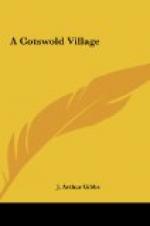Many another species of wild flower which, “born to blush unseen and waste its sweetness on the desert air,” grows in the quiet Cotswold lanes might here be named; but even though at times one may feel, with Wordsworth,
“To me the meanest
flower that blows can give
Thoughts that
do often lie too deep for tears.”
I will leave the humble wayside plants and descend into the vale. For it is along the back brook that the tallest and stateliest wild flowers may best be seen. The scythes mowed them all down in May, and again in July, in the broad “millpound,” so that they do not grow so tall by the main stream; but the back brook, the natural course of the river before the mills were made, was left unmolested by the mowers, and is a mass of life and colour.
Here grows the graceful meadow-sweet, fair and tall, and white and fragrant; here the willow-herb, glorious with pink blossoms, rears its head high above your shoulders among the sword-flags and the green rushes and “segs”; the whole bank is a medley of white meadow-sweet, scorpion-grasses, forget-me-nots, pink willow-herbs, and lilac heads of mint all jumbled up together. Never was such a delightful confusion of colour! Great dock leaves two feet wide clothe the path by the water-side with all the splendour of malachite.
The breeze blows up stream, and the trout are rising incessantly, taking something small. They will not look at any artificial fly, even in the rippling breeze; there is nothing small enough in any fly-book to catch them this afternoon. But when the sun gets low, and the great brown moths come out and flutter over the water, the red palmer will catch a dish of fish. Willow trees—“withies” they call them hereabouts—grow along the brook-side. So white are the backs of their oval leaves that when the breeze turns them back, the woods by the river look bright and silvery. To-morrow, when the breeze has almost died away, only the tops of the willows will be silvered; the next day, if all be calm and still, all will be green as emerald. Such infinite variety is there in the woods! Not only do the tints change month by month, but day by day the colour varies; so that there is always something new, some fresh effect of light and shade to delight the eye of man in the quiet English country. Dotted about in the midst of the stream are little islands of forget-me-nots. The lovely light blue is reflected everywhere in the water. Very beautiful are the scorpion-grasses both on the banks among the rushes and scattered about in mid stream.
The meadows are full of life. There are sounds sweet to the ear and sights pleasing to the eye. In the new-mown water-meadow grasshoppers—such hosts of them that they could never be numbered for multitude—are chirping and dancing merrily. “They make the field ring with their importunate chink, whilst the great cattle chew the cud and are silent. How like the great and little of mankind!” as Edmund Burke said years ago. By catching one of these “meagre, hopping insects of the hour,” you will see that their backs are green as emerald and their bellies gold: some have a touch of purple over the eyes; their thighs, which are enormously developed for jumping purposes, have likewise a delicate tinge of purple.




